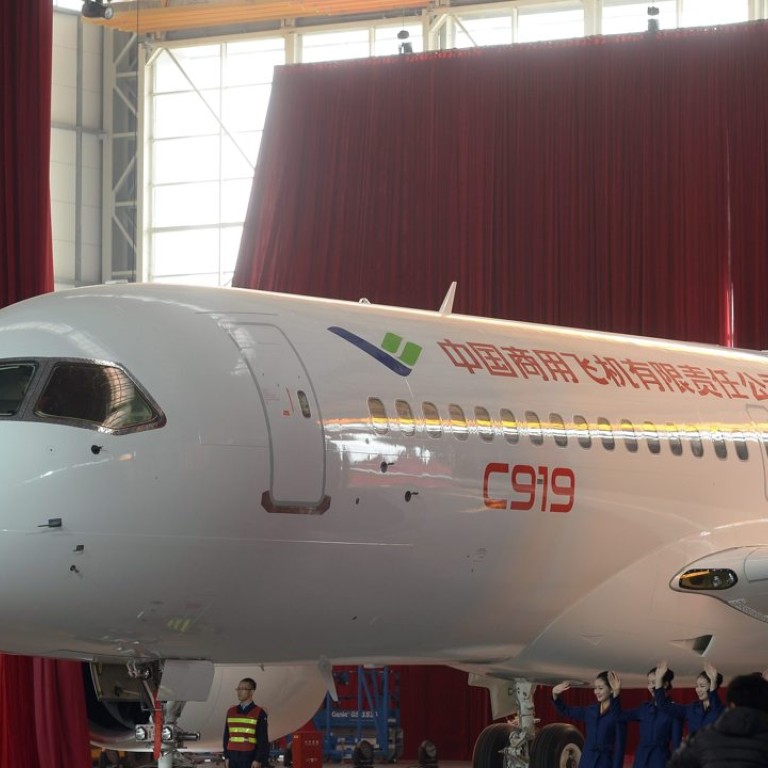
Plane sailing: Titanium-made aircraft may give China new edge in aviation as scientists develop method to make pure metal better than alloys
Scientists say new material could make Chinese aeroplanes 10 per cent tougher than Western rivals, and safer to boot, but same tech may find initial applications in surgery, implants
A breakthrough in material science could help China make large aircraft that are at least 10 per cent tougher than their foreign competitors, with significantly less chance of metal fatigue, according to Chinese scientists.
The technology can make pure metal, such as titanium, stronger than the best alloys in use today while maintaining a high level of elasticity to “prevent catastrophic failure during service,” the research team said.
They published their findings in the Proceedings of the National Academy of Sciences of the United States of America.
“It would be very possible for a big [Chinese] aircraft to use our new material. That’s the purpose of our research,” said Professor Wu Xiaolei, a lead scientist of the project who works with the Chinese Academy of Sciences’ Institute of Mechanics.
“A wholly titanium plane would not only be stronger, but stay longer in service, be more fuel efficient with significant weight reduction, and much, much cheaper to build,” he added.
READ MORE: C919 unveiled: China trumpets first homegrown jetliner in bid to compete with Boeing, Airbus
Since ironsmiths discovered long ago that pure metal could be given extra strength by mixing it with other elements, alloys have come to replace pure metal in almost every sector of human industry.
For centuries, much effort was concentrated on the search for better alloys, with the list of mixing materials growing longer and the manufacturing process becoming increasingly sophisticated.
But Wu, together with Professor Zhu Yuntian from North Carolina State University in the United States, decided to head in the opposite direction.
In recent years, the rapid advancement of nano-technology has allowed scientists to develop materials from the same metal source but with very different physical traits, largely due to variations in their micro-structure.
By combining these materials, researchers found it was possible to bestow on pure metal some extraordinary physical properties.
But one nagging dilemma remained: Whether to go for greater strength or more flexibility.
Though nano-technology has helped researchers develop especially hard or flexible metals, they were unable to combine the two properties - an essential step for their real-life application.
Aircraft require both of these in a high degree as they may experience metal fatigue after extended periods of service that can potentially prove catastrophic.
It was long believed that pure metals would always be limited in their application, but Wu’s team claim to have solved the problem.
Using a new fabrication method, they brought hard and elastic titanium sheets together and created a new kind of pure titanium that is not only strong but ductile.
Their findings “provided a new principle for designing metals with mechanical properties that have not been reachable before,” the authors wrote in their paper.
Wu and his colleagues were surprised by how well the pure titanium performed compared to the alloys used in modern aircraft.
Their laboratory test results showed that the new pure material could be 15 per cent tougher than Ti6a14v - a special titanium alloy used in plane engines and structural components such as the hull and frame - and up to 20 per cent more flexible.
This meant it was much less likely to experience metal fatigue, they said.

It could also give China a strategic advantage in aviation.
The formula and manufacturing process of special alloys are among the most guarded industrial secrets by Western countries, and China has been struggling to compete with them with high-quality products of its own.
“China can make high-quality alloys, but they are not better than similar products overseas,” Wu said.
“To sell our planes and other high-end industrial products abroad, our materials must be way better than those of our competitors - and now we have a chance [to do that].”
Professor Xiong Yuexi, an expert in plane design at Beihang University in Beijing, said the new breakthrough could trigger a “revolution” in the aviation industry if the technology performs as reported.
“Materials are very important to plane manufacturers. [Using the right one] is a matter of life and death,” he said.
“I can’t wait to learn more about this new material and related technology.”
But Xiong cautioned that it could take a long time before the new material is applied to aircraft as extensive tests are first required both in the lab and field.
The new material must also prove it can handle the impact of acid rain and other environmental factors which could potentially erode it or cause other damage.
However, Wu said the new development has already caught the eye of manufacturers in China. He said part of its appeal is that it is simpler to make than most alloys.
But before it is used in planes, it may find its way onto the operating table.
“The first application of the new material will [likely] be in heart surgery,” Wu said.
“Pure titanium does not contain elements found in most alloys that can be harmful to people’s health, so it is perfect for metallic implants,” he added.
“We are working with several companies to bring the technology from the lab to people’s lives as soon as possible.”
The researchers said the technology may later be applied to other metals like iron.
“In the future we may have pure-iron cars that will be much safer and more fuel-efficient than those made with steel alloys today,” Wu said.

